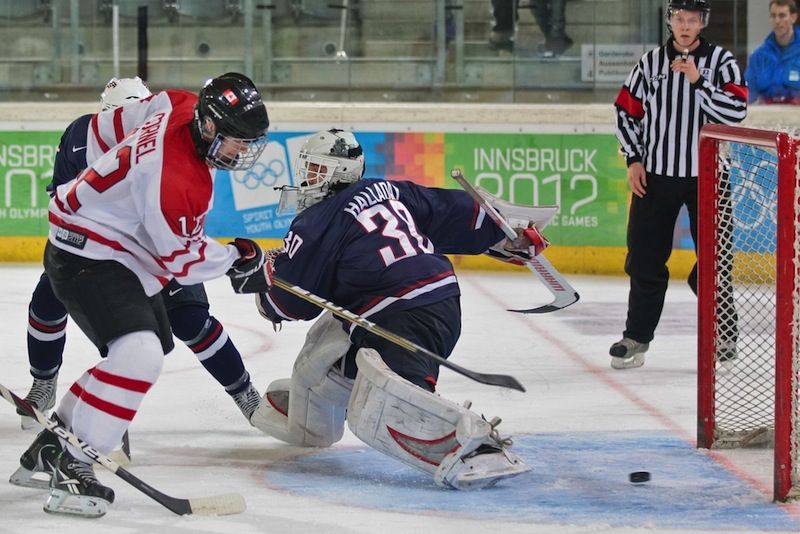
Fighting Hockey Concussions with Safer Helmets (Op-Ed)

John Varrasi is a senior staff writer for the American Society of Mechanical Engineers (ASME). He contributed this article to Live Science's Expert Voices: Op-Ed & Insights.
As a new hockey season dawns, mounting concerns about concussions are inspiring Virginia Tech researchers to evaluate the sport's helmets for safety and durability. The tests involve embedded sensors, real-world conditions in an ice rink and controlled impacts in a laboratory. And the research will lead to specific ratings for a variety of helmet models and brands, particularly concerning their potential to reduce concussion risk.
"Part of the strategy to reduce the incidences of concussions at all levels of competitive hockey involves improvements in head protection," said Steven Rowson, assistant professor of biomedical engineering at Virginia Tech. "The aim of our research is to identify helmets that demonstrate the strongest potential to minimize the risk of on-ice concussions."
An epidemic
A sports concussion occurs when the head is accelerated during an impact, creating different relative motions in the brain and skull and causing pressure to build up inside the skull that strains the brain tissue.
Concussions in football have garnered the most public attention, and two years ago, the Virginia Tech Biomedical Engineering Department developed a successful rating system for football helmets. However, in the last 10 to 15 years, there has been an alarming increase in the number of concussions suffered by professional, collegiate and youth hockey players. Eighty National Hockey League (NHL) players sustained concussions in the 2010 to 2011 season, compared to 60 in the 1997 to 1998 season. Concussions have occurred in players ranging from former superstar Eric Lindros, who skated for the Philadelphia Flyers in the 1980s and 1990s, to lesser-known NHL professionals who have played smaller roles on teams. Former NHL players have filed six concussion-related lawsuits in U.S. courts, with many more expected in the near future. [Preventing Concussions is About Care, Not Coddling (Op-Ed)]
Concussions in youth hockey are difficult to gauge, chiefly because reliable medical assessments generally are not performed at youth hockey games, and also because peewee and high-school players oftentimes neglect to report dizziness and other concussion symptoms to coaches and parents. But experts contend that many concussions do occur in youth hockey; a recent article in the Journal of Sports Engineering and Technology mentioned that a sample of 13-year-old male and female hockey players suffered head impacts equal in magnitude to measured values occurring in American collegiate football players.
Sign up for the Live Science daily newsletter now
Get the world’s most fascinating discoveries delivered straight to your inbox.
How to test hockey helmets
Rowson, an ASME member, said his research will improve safety. He and his colleagues have developed laboratory testing-conditions that are representative of real-world head impacts. The researchers will also draw on research compiled at Brown University and Dartmouth College, which have placed instruments in ice hockey helmets to collect head-impact data directly from players. In addition, Rowson and his team rented a hockey rink in Roanoke, Virginia, to use in identifying how a rink's sideboards, glass and ice create different head collisions.
"Together, these studies inform our testing methods, enabling us to reconstruct real-world head impacts," said Rowson.
In some of the tests, a custom-designed impact pendulum will emulate on-ice impacts by striking a "head" form outfitted with accelerometers and angular-rate sensors. The testing puts each helmet through a variety of impacts, which differ in impact location (front, rear, side and top) and impact velocity. The sensors measure linear as well as rotational head acceleration, which is critical for determining concussion risk.
The testing system allows researchers to model the various ways in which the force of an impact transfers from the helmet to the head. "Hockey helmets modulate energy transfer to the head during impact in a variety of configurations," he said. "Our testing methodology enables us to map head impact exposure to specific energy levels and impact locations on the helmet."
The resulting data is showing researchers how frequently players experience various head impacts, and the probability of injury from a given amount of head acceleration. The data will reveal the likelihood of a concussion for a range of impacts in a given helmet, and an overall prediction for the number of concussions a player might experience over a full hockey season while wearing a given helmet.

Getting manufacturers to step up
While some in sports medicine dismiss the role of improved helmet designs in reducing concussions in hockey and other competitive sports, Rowson said he firmly believes that new headgear can be a blueprint for less brain damage.
Football helmet manufacturers, which post Virginia Tech's ratings on their products, seem to be buying in to Rowson's assessment. For example, sports equipment manufacturer Riddell has introduced a football helmet featuring an exterior panel that can move slightly inward to absorb hits to the crown of the head, essentially dispersing energy from a blow.
"It is a challenge for manufacturers to optimize helmet designs, because you must account for so many different impact scenarios," said Rowson. "While we are not specifically telling manufacturers how to revise their designs, we do believe that the quest to produce a helmet that lowers head acceleration — and as a result, reduces the risk of concussion — should not be abandoned. We want to provide sporting goods manufacturers with a set of performance criteria for helmets that can be used to reduce the probability of concussion."
Follow all of the Expert Voices issues and debates — and become part of the discussion — on Facebook, Twitter and Google+. The views expressed are those of the author and do not necessarily reflect the views of the publisher. This version of the article was originally published on Live Science.











